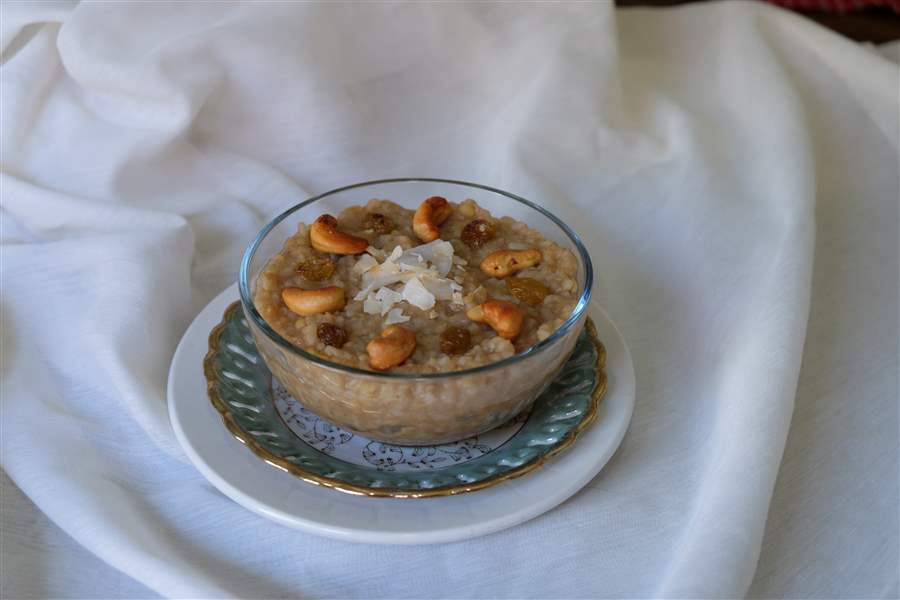
Toledo Sister Cities
Sakkarai pongal a special treat from southern India
6/12/2018
Sakkarai Pongal (Sweet Rice and Dal Pudding)
The Blade/Jetta Fraser
Buy This Image
Even fans of Indian food tend to think of the country’s cuisine as a monolithic whole. But there are distinct regional differences, particularly between the north and the south.
Northern Indian dishes include “more fritters and fried foods,” said Paresh Dalwalla, who serves on the board of directors for Toledo Sister Cities International and is the trustee for our sister city, Coimbatore. A typical dish, he said, might be paneer (a type of fresh cheese) served in a creamy gravy. In the south, though, where Coimbatore is located, “they tend not to use cream and [use] less oil,” he said.
“The southern region, they’re very focused on low-fat foods,” with a strong emphasis on vegetarianism.
Although Mr. Dalwalla is originally from Mumbai, more than 700 miles north of Coimbatore, his wife, Lakshmi, is from Bangalore, not terribly far from our sister city. So he is very familiar with the foods of southern India.
Coimbatore is known for the arts, and musicians, dancers, and other artists from there have performed in Toledo, fostering a deeper friendship between our cities. Additionally, Mr. Dalwalla said, the city has a strong auto base “because it is close to Chennai, which is a big automotive hub” that’s been nicknamed the Detroit of India.
“It’s up and coming,” he said of Coimbatore, which was selected by Prime Minister Narendra Modi to participate in the Smart Cities Mission for user-friendly and sustainable urban development.
Agriculturally, “rice is the major product” in southern India, said Mr. Dalwalla. It is found in both sweet and savory dishes.
A classic southern dish is khichdi, a spiced — but not spicy — mixture of lentils and rice. It is sometimes promoted as the national dish of India and called the “queen of all foods” for its nutritional properties.
While many people are familiar with the breads, such as roti and naan, and curries of the north, Coimbatore offers deliciously distinctive foods such as dosas (large crèpes prepared from a fermented, pulse and rice-based batter) and idli (small, savory steamed pancakes made of rice with lentils), both of which are served with chutneys or with a hot vegetable-laden stew called sambar.
Soup-like rasam, with a sweet-sour tamarind base, is “very liquidy,” Mr. Dalwalla said. It is similar to, but much thinner than, sambar. “It’s made out of gram,” he said, specifically a pulse known as horse gram that is considered to have beneficial qualities in Ayurvedic medicine. “People drink it to open up the sinuses” and to alleviate allergies, he said, because of its abundance of spices and herbs.
One of the favorite desserts in southern India is payasam, a pudding of rice and milk that has been boiled “to make it a little more creamy,” Mr. Dalwalla said. “Then it is sweetened with sugar. This is often served for celebrations and festivals.”
Another beloved treat for holidays is pongal, “made with rice and dal and sugar,” he said. It is topped with ghee-toasted nuts and raisins.
Enjoy this special introduction to the cuisine of our sister city, Coimbatore.
Sakkarai Pongal (Sweet Rice and Dal Pudding)
This is a special treat for holidays and festivals. The serving instructions say it should be “offer[ed] to the goddess or you can serve sweet pongal hot or warm to your family members.”
RICE AND DAL
½ cup regular rice
⅓ cup split moong dal without husks (see note)
3 cups water
SYRUP:
½ cup jaggery or dark brown sugar (see note)
½ cup water
½ teaspoon ground cardamom
Pinch of ground clove
FRUIT:
3 tablespoons ghee (see note)
⅓ cup cashews
1 tablespoon golden raisins
Toasted coconut, for garnish
Pick through the rice and dal to get rid any stones. Place them into a 3-quart saucepan and cook over a low flame, stirring often, just until they become aromatic. There is no need to brown them.
Add the 3 cups water and bring to a boil, then cover and lower heat to simmer for 20 minutes or until the water has been absorbed and the rice and dal are cooked through. Let rest, covered, for 10 minutes off the heat, then slightly mash the rice and dal and stir together.
While the rice is cooking, place the syrup ingredients into a small saucepan. Cook over low heat, stirring, until the sugar melts.
Melt the ghee in a small saucepan. Add the cashews and sauté until they become light golden. Add the raisins and cook until they plump up.
Combine the syrup with the rice mixture. The pongal will thicken as it cools, so if the mixture looks thick, add ¼ to ⅓ cup hot water. Stir in most of the fruit-nut mixture, including any remaining ghee in the pan.
Divide among six dishes and top each with a bit of the remaining fruit-nut mixture. Garnish with coconut and serve warm.
Note: Moong dal, jaggery, and ghee are available at Deepam India, 7406 Central Ave.
Yield: 6 servings
Source: Adapted from Dassana Amit, vegrecipesofindia.com
Contact Mary Bilyeu at 419-724-6155 or mbilyeu@theblade.com, and follow her at facebook.com/thebladefoodpage.